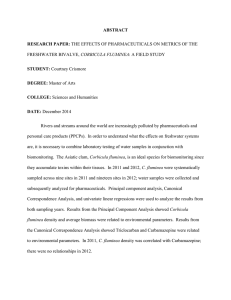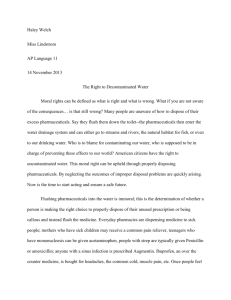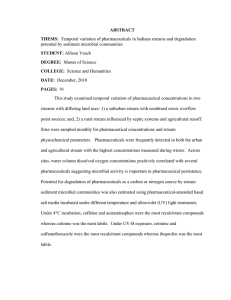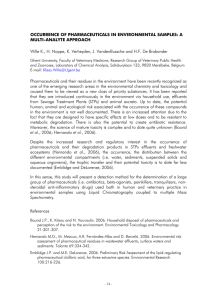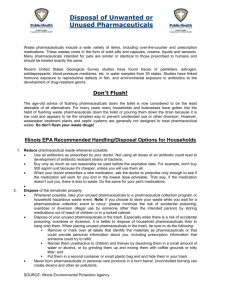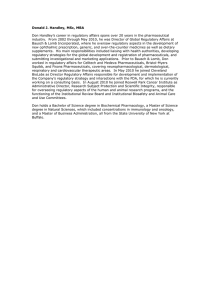THE EFFECTS OF PHARMACEUTICALS ON METRICS OF THE FRESHWATER CORBICULA FLUMINEA
advertisement
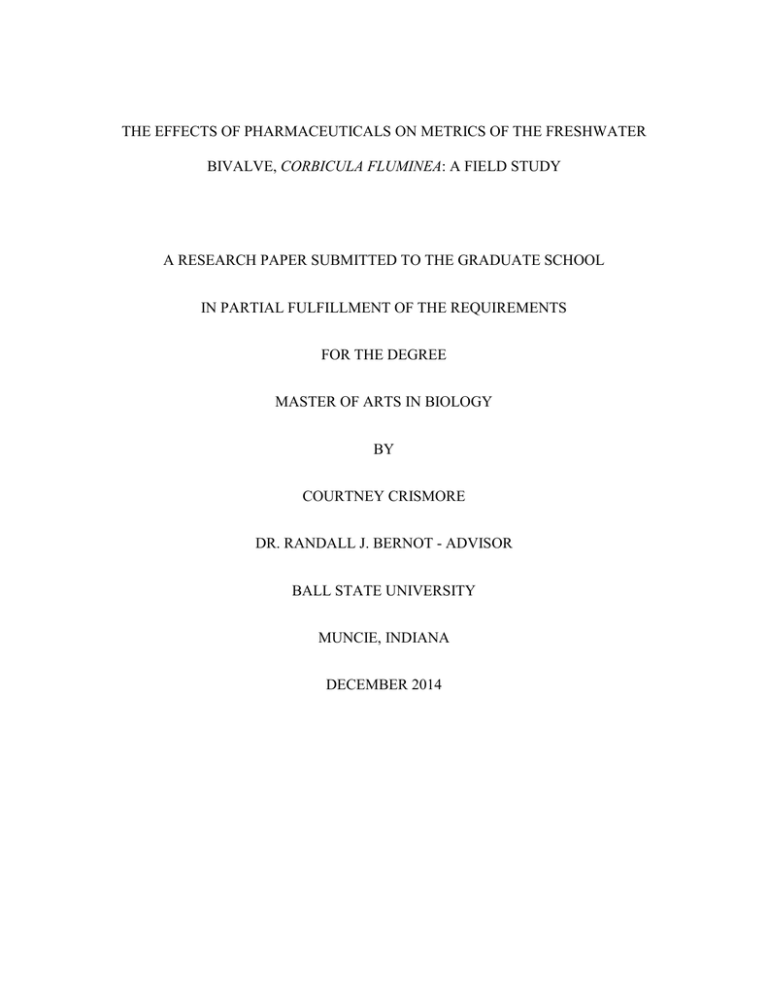
THE EFFECTS OF PHARMACEUTICALS ON METRICS OF THE FRESHWATER BIVALVE, CORBICULA FLUMINEA: A FIELD STUDY A RESEARCH PAPER SUBMITTED TO THE GRADUATE SCHOOL IN PARTIAL FULFILLMENT OF THE REQUIREMENTS FOR THE DEGREE MASTER OF ARTS IN BIOLOGY BY COURTNEY CRISMORE DR. RANDALL J. BERNOT - ADVISOR BALL STATE UNIVERSITY MUNCIE, INDIANA DECEMBER 2014 TABLE OF CONTENTS TABLE OF CONTENTS ........................................................................................... ii ACKNOWLEGEMENTS ......................................................................................... iii INTRODUCTION ......................................................................................................1 METHODS .................................................................................................................3 RESULTS ...................................................................................................................7 DISCUSSION .............................................................................................................9 REFERENCES .........................................................................................................12 FIGURES AND TABLES ........................................................................................14 ii ACKNOWLEDGEMENTS I would like to thank all those who assisted in the completion of my thesis project. I thank the various Ball State University graduate students, especially James Justice, Lindy Caffo, Rachel Kobernick, Patricia Flores, Hilary Madinger, Jee Hwan Lee, and Daniel Elias for long hours of field sampling. I also thank Jason Doll for help with statistical analysis and David Starzynski for his editorial comments. iii INTRODUCTION The presence of a wide variety of pollutants in rivers and streams has become an area of focus for environmental scientists and biologists worldwide (Murray 2010). Effective monitoring of contaminants within a watershed is crucial to the improvement of water quality (Neufeld 2009). Personal care products (PPCPs) and pharmaceuticals are commonly detected within surface waters (Brausch and Rand 2011). Human consumption of pharmaceuticals, including disinfecting agents, non-steroidal anti-inflammatory drugs, and anti-psychotics, is substantial (Brausch and Rand 2011). While the presence of pharmaceuticals is known, the factors related to their persistence and availability to aquatic organisms are largely unknown (Veach and Bernot 2011). To understand the presence and risks of pharmaceuticals in the environment, long-term exposure assessments of aquatic organisms to pharmaceuticals are essential (Fent et al. 2006). Limited data on the occurrence and temporal variability of pharmaceuticals in freshwater environments exist because of the difficulty and expense involved in the analyses (Murray 2010). The current methods for pharmaceutical sampling only reflect the concentrations that are present at the time of sampling, which does not account for fluctuations. Temporal variability of contaminants in the environment can occur depending on what time of the day and what day of the week the sampling is completed (Gerrity et al. 2011). In addition, certain pharmaceuticals undergo photodegradation once they are present in surface waters, making it difficult to detect the original compound (Fent et al. 2006). Various studies have used bivalves as biomonitors, or organisms that accumulate toxins and reflect the amount of bioavailable contamination in the environment (Neufeld 2009). Corbicula fluminea are an ideal organism to use for biomonitoring because of their ability to bioaccumulate a wide range of toxins such as trace metals, polychlorinated biphenyls (PCBs), 1 chlorinated pesticides (HLPs), herbicides and insecticides (Cataldo et al. 2001). Benefits of using C. fluminea as water quality indicators include their longevity and sensitivity to pharmaceuticals present in the environment (Cataldo et al. 2001). The use of freshwater bivalves to monitor pharmaceuticals and other contaminants in aquatic environments provides a spatial and temporal view of the contaminants and their effects on aquatic organisms. Corbicula fluminea have become increasingly useful in ecological laboratory and field experiments due to their high filtration rate and ability to acquire nutrients from the water column and from the sediment (Vaughn and Hakenkamp, 2001). Corbicula fluminea, also known as the Asiatic clam, is an invasive species that has expanded its habitat to include the Americas and Europe within the last few decades (Korniushin and Glaubrecht, 2003). Due to their high filtration rate, C. fluminea could reduce the amount of zooplankton and nutrients available to native unionid mussels in the water column (Vaughn and Hakencamp 2001). A study by Way et al. (1990) found that C. fluminea can adapt to food availability in the water column by adjusting the rates in which they filter feed. Small bivalve species, such as C. fluminea, have the ability to supplement filter feeding by acquiring nutrients through the sediments, also known as pedal feeding (Reid et al. 1992). Recently, C. fluminea have been used in a wide variety of studies investigating the detrimental effects of a variety of pollutants on their growth, mortality, and fecundity (Chen et al. 2009). Cataldo et al. (2001) examined the effects of major priority pollutants including chlorinated pesticides, aliphatic hydrocarbons, and heavy metals on the survival rate of C. fluminea. The chemicals used in their laboratory assessment were frequently detected in river water and sediment across four different sites. Mortality rates of C. fluminea exposed to 2 contaminated sediment from the four sites were higher than those exposed to water alone (Cataldo et al. 2001). The objectives of this study were threefold. First, we determined whether any relationships existed between C. fluminea metrics (mean shell length, biomass, density, and biomass density) and environmental data in the White River and Mississinewa River watersheds. We hypothesized that C. fluminea metrics would be influenced by environmental conditions. Second, we determined whether there were any relationships between environmental parameters and pharmaceutical concentrations in the streams. We hypothesized that pharmaceuticals would be influenced by physiochemical parameters. Third, we determined whether C. fluminea metrics were influenced by pharmaceuticals in the streams. We hypothesized that pharmaceuticals would negatively affect C. fluminea metrics. METHODS Study area: The Upper White River watershed (7,044 km2) and Mississinewa River watershed (2,037 km2) are located in east-central Indiana (Figure 1). Land usage within the Upper White River watershed is approximately 60% agriculture, 30% developed urban areas, 5% forest, and 5% other. Land usage within the Mississinewa River watershed is approximately 65% agriculture, 20% developed urban areas, 10% forest, and 5% other. In August 2011, six of the sampling sites were located in the Upper White River watershed. The remaining three sites were located in the Mississinewa River watershed. In 2012, an additional ten sites were sampled; of those sites, six were located in the Upper White River watershed, and the remaining four sites were located in the Mississinewa River watershed. 3 Corbicula fluminea Sampling 2011: Corbicula fluminea were sampled using an adaptive sampling method with initial random samples as described in Strayer and Smith (2003). Each site was 20 m in length, and width measurements were recorded in increments of 1 m. A random numbers chart was used to select quadrats from a sampling grid of each location. Sampling quadrats were constructed of polyvinyl chloride (PVC) tubing and measured 0.50 m2 (Strayer and Smith 2003, Bowley 2010). The quadrats were secured in one of four randomly selected locations from the sampling grid. Sediment was removed within each quadrat to a uniform depth of 10-15cm. A maximum number of C. fluminea per quadrat for each site was chosen based on preliminary investigation of abundance at each site. A maximum number was chosen ahead of time in order to determine if the neighboring quadrats needed to be sampled (Bowley 2010). According to the adaptive sampling method, all C. fluminea within the first quadrat were removed, and if the maximum number was not met, sampling proceeded to the next random quadrat (Strayer and Smith 2003). If the maximum number of C. fluminea was met, the four neighboring quadrats (in a cross-shaped pattern) were sampled (Bowley 2010). This method continued until all four quadrats were completely sampled, or until one of the neighboring quadrats did not exceed the maximum number. A site was considered complete when all four of the initially selected quadrats, and any subsequent neighboring quadrats, were sampled (Bowley 2010). All collected C. fluminea were preserved with 10% formalin in labeled glass jars. All mussels were measured for length; biomass for each clam was determined using the following length-mass equation from Bagatini et al. (2007) W= (2.92x10-4) x (L2.79 ). 4 Corbicula fluminea Sampling 2012: Corbicula fluminea were present at all sites in high densities, so the 2011 sampling method was adapted to account for this issue. Each quadrat was sampled for exactly ten minutes, and all C. fluminea were removed from the quadrat and placed in a Nalgene bottle to be taken to the lab. All collected C. fluminea were preserved in labeled jars with 10% formalin. All clams were measured for length, and biomass for each clam was determined using following lengthmass equation from Bagatini et al. (2007) W= (2.92x10-4) x (L2.79 ). Temperature, conductivity, salinity, total dissolved solids (TDS), pH, and dissolved oxygen were measured at each site using a Hydrolab minisonde 5 (Hydrolab). Depth and flow were recorded at each site using a Flo-Mate model 2000 (Marsh-McBirney). Grab samples of water were collected from each site to determine pharmaceutical and cation concentrations. Facing upstream, the syringe was filled with river water and filtered into 1 liter amber glass bottles using a 60mL syringe with Whatmann GF/F 25mm glass fiber filters. All water samples were preserved on ice and transported to the Indiana State Department of Health (ISDH) chemistry laboratories in Indianapolis, IN. Extraction and analysis of 1 liter water samples followed the USGS Method 5-B5 (Furlong et al. 2008). Samples were preserved at the laboratory with 5 ml of a 5% EDTA solution and refrigerated until extracted to a final volume of 1 mL. Calibration curves used for quantization had a correlation coefficient of 0.99 or better. Analysis was performed on an Agilent 1200 Liquid Chromatograph and Applied Biosystems API4000 MS/MS in both positive and negative modes (Furlong et al. 2008). Standards for Gemfibrozil, Lincomycin, Sulfamethoxazole, Trimethoprim, and Tylosin Tartrate were purchased from Sigma (St. Louis, MO). Acetaminophen, Caffeine, 5 Carbamazepine, - (-)Cotinine, N,N-Diethyltoluamide (DEET), Ibuprofen, Naproxen, Sulfadimethoxine, Sulfamerazine, Sulfamethazine, Sulfathiazole, and Triclosan were purchased from Absolute Standards (Hamden, CT). Triclocarban standards were purchased from AccuStandard, New Haven, CT. Internal standards were isotopically labeled and included Acetaminophen, Caffeine and Cotinine from Cerilliant, Round Rock, TX, and N,NDiethyltoluamide (DEET), Ibuprofen, Naproxen Sulfamethazine, Sulfamethazole, Triclosan, and Trimethoprim, from Cambridge Isotope Laboratories (Andover, MA). Oasis HLB 6cc (500 mg) LP Extraction Cartridges, part # 186000115, from Waters (Milford, MA) were used for all extractions; an Agilent Eclipse XDB-C18 2.1 x 150 mm, 3.5µm LC column, part #930990-902, was used for all analyses. Water samples for cation analysis were filtered into 60mL Nalgene bottles using a 60mL syringe with Whatmann GF/F 25mm glass fiber filters. The samples were then placed on ice and transported back to Ball State University where they were analyzed with a Dionex ICS-3000 (Dionex) ion chromatograph for fluoride, chloride, nitrite, bromide, nitrate, phosphate, and sulfate concentrations. Statistical Analyses: Major gradients in the stream environmental variables were identified using Principal Component Analysis (PCA) with a correlation matrix. Additional variables were measured in 2012; therefore data were analyzed separately by year. For 2011, the following environmental variables were included in the PCA: stream discharge, temperature, salinity, total dissolved solids, pH, and dissolved oxygen. We retained the Principal Component axes with eigenvalues > 1.0 for interpretation (Lopez-Darias et al. 2012). For 2012, the following environmental 6 variables were included in the PCA: temperature, pH, specific conductivity, dissolved oxygen, salinity, total dissolved solids, stream width, mean stream depth, fine benthic organic matter, course benthic organic matter, ammonia, and total carbon. Again, only Principal Component axes with eigenvalues > 1.0 were used for interpretation. We used a Canonical Correspondence Analysis (CCA) to determine the relationship between pharmaceutical concentrations and environmental variables. The angles and lengths of the arrows associated with the environmental variables are used to visualize their importance in relation to pharmaceutical distribution (Rejmankova et al. 1991). The angle displays the direction of the relationship and the length represents the strength (i.e., longer arrows represent a stronger relationship). We measured additional environmental variables in 2012; therefore each year was analyzed separately. The significance of the relationships between pharmaceuticals and environmental variables were tested using an analysis of variance (ANOVA) permutation test. We used an AIC model selection to identify the best subset of environmental variables to describe pharmaceutical abundance. AIC selects the best model based with a penalizing function for increased complexity. Significance was set at α = 0.05. Univariate linear regression was used to determine the relationship between individual pharmaceutical concentrations (ng/L) with C. fluminea metrics for each sampling year separately. We used a Bonferroni correction to maintain family-wise error rate of 0.05 to control for Type 1 error (Eleven models: α=0.004 for both years). RESULTS In 2011, Principle Component axes 1 and 2 had eigenvalues > 1.0; axis 1 explained 47.75% of the variation, and axis 2 explained 25.53% of the variation (Table 1). Discharge, 7 temperature, and pH loaded strongly onto axis 1, and temperature and salinity loaded strongly onto axis 2 (Table 2; Figure 2). In 2012, Principle Component axes 1, 2, 3, and 4 had eigenvalues > 1.0; axis 1 explained 31.59% of the variation, axis 2 explained 24.96% of the variation, axis 3 explained 13.32% of the variation, and axis 4 explained 9.7% of the variation (Table 3). Salinity, total dissolved solids (TDS), and specific conductivity loaded strongly onto axis 2, temperature, course benthic organic matter (CBOM), and pH loaded strongly onto axis 3, and dissolved oxygen and fine benthic organic matter (FBOM) loaded strongly onto axis 4 (Table 4). Linear regressions with C. fluminea metrics as a function of Principle Component axis 1 showed a relationship with average biomass (R2 = 0.374, p = 0.005). Linear regressions with C. fluminea metrics as a function of Principle Component axes 2 (R2 = -0.053, p = 0.661), 3 (R2 = 0.03, p = 0.240), and 4 (R2 = -0.067, p = 0.958) did not show any relationships. In 2011, The Canonical Correspondence Analysis’ Constrained Axis 1 had an eigenvalue of 0.54 and Constrained Axis 2 had an eigenvalue of 0.45 (Table 5). Carbamazepine, Sulfamethoxazole, Triclocarban, Gemfibrozil, and Sulfamethazine loaded strongly on axis 1 (Table 6). Carbamazepine, Lincomycin, Sulfamethoxazole, Triclocarban, and Gemfibrozil loaded strongly on axis 2 (Table 6). The permutation test indicated the full model was not significant (F(6,2) = 0.740, P = 0.840). The best model based on AIC was Pharmaceuticals from 2011~Temp+Sal+LDO (Table 7). The permutation test for the best model was significant (F(3,5) = 1.69, P = 0.041). In 2012, Constrained Axis 1 had an eigenvalue of 0.57 and Constrained Axis 2 had an eigenvalue of 0.47 (Table 8). Acetaminophen and Ibuprofen loaded strongly onto axis 1, and 8 Acetaminophen, Ibuprofen, and Triclocarban loaded strongly onto axis 2 (Table 9). The permutation test indicated the full model was not significant (F(6,2) = 0.740, P = 0.840). The best model based on AIC was Pharmaceuticals from 2012~pH+Temp+DO+TDS+WettedWidth+MeanDepth+FBOM+CBOM+NH4N+TC (Table 10). The permutation test for the best model was significant (F(11,5) = 2.39, P = 0.01). For 2011, C. fluminea density and Carbamazepine were positively correlated (Figure 5, Table 11). For 2012, linear regressions with C. fluminea metrics and individual pharmaceutical concentrations did not show any relationships (Table 12). DISCUSSION Our first objective was to determine if any relationships exist between Corbicula fluminea metrics and environmental data in the White River and Mississinewa River watersheds from 2011 and 2012; we hypothesized that C. fluminea metrics would be influenced by environmental conditions. In 2011, Principle component axis 1, stream discharge, temperature, and pH, was significantly related to C. fluminea density. As temperature, stream discharge, and pH decreased, so did C. fluminea density. In 2012, Principal component axis 1 was significantly related to average biomass. A study conducted by Sousa et al. (2008) investigated C. fluminea abundance, biomass and population structure across two years, and developed a model describing the relationship between environmental variables and C. fluminea data in the freshwater tidal area of the River Minho estuary in Lugo, Spain. They used stepwise multiple regression analysis to determine if there were any relationships between C. fluminea biomass and the measured environmental variables (Sousa et al. 2008). Their results showed smaller C. fluminea biomass with increased 9 salinity, and higher values of nitrates and ammonia. Greater C. fluminea biomass were observed with increased redox potential, organic matter, hardness, very coarse sand and fine sand (Sousa et al. 2008). Our second objective was to determine if there are any relationships between environmental data and pharmaceuticals in the streams for 2011 and 2012. We hypothesized that pharmaceuticals would be influenced by environmental conditions. In 2011, the AIC best fit model showed temperature was related to Triclocarban and Carbamazepine. As temperature increased, so did the concentrations of Triclocarban and Carbamazepine. In 2012, total dissolved solids, salinity, and specific conductivity were related to Triclocarban, and temperature and pH were related to Acetaminophen. As total dissolved solids, salinity, and specific conductivity decreased, so did concentrations of Triclocarban. As temperature and pH increased, so did concentrations of Acetaminophen. Togota et al. (2007) investigated the effects of temperature and salinity on the uptake rate of pharmaceuticals in a laboratory setting. As temperature increased (from 5 degrees Celcius to 21 degrees Celcius), so did the uptake rate of all pharmaceuticals with the exception of carbamazepine; carbamazepine uptake rate stayed constant at both temperatures. Pharmaceuticals that are acidic compounds showed no significant effects with a salinity increase. Pharmaceuticals that are basic compounds showed a significant decrease in uptake rate with a salinity increase (Togota et al. 2007). Our third objective was to determine if Corbicula fluminea metrics were influenced by pharmaceuticals in the streams. We hypothesized that pharmaceuticals will negatively affect C. fluminea metrics. Further, we hypothesized that pharmaceuticals will have different effects on C. fluminea metrics. For 2011, C. fluminea density and Carbamazepine were positively 10 correlated. For 2012, linear regressions with C. fluminea metrics and individual pharmaceutical concentrations did not show any relationships. Carbamazepine is a ubiquitous compound that is found in freshwaters worldwide, allowing long-term exposure to organisms. Carbamazepine was found to have sublethal effects on the macroinvertebrate Stenonema sp. Changes in development and behavior were observed with carbamazepine exposure at environmentally relevant concentrations (2, 20, 200, 2000 ng/L) (Jarvis et al. 2014). Although there was no observed increase in mortality at environmentally relevant concentrations, long-term exposure to carbamazepine has a negative effect on the lifecycle of Stenonema sp. (Jarvis et al. 2014). 11 REFERENCES Bagatini, Y.M., J. Higuti, and E. Benedito. 2007. Temporal and longitudinal variation of Corbicula fluminea (Mollusca, Bivalvia) biomass in the Rosana Reservoir, Brazil. Acta Limnologica Brasiliensia 19: 357-366. Bowley, Laura A. 2010. Burea of Water Quality annual macroinvertebrate report 2010: 1-127. Brausch, J.M. and G.M. Rand. 2011. A review of personal care products in the aquatic environment: Environmental concentrations and toxicity. Chemosphere 82: 1518-1532. Cataldo, D., J.C. Colombo, D. Boltovskoy, C. Bilos, and P. Landoni. 2001. Environmental toxicity assessment in the Parana River delta (Argentina): simultaneous evaluation of selected pollutants and mortality rates of Corbicula fluminea (Bivalvia) early juveniles. Environmental Pollution 112: 379-389. Chen, W.Y., C.M. Liao, L.J. Jou,and S.F. Jau. 2009. Predicting bioavailability and bioaccumulation of arsenic by freshwater clam Corbicula fluminea using valve daily activity. Environmental Monitoring and Assessment 169: 647-659. Fent, K., Weston, A.A., and Caminada, D. 2006. Ecotoxicology of human pharmaceuticals. Aquatic Toxicology 76: 122-159. Furlong, E.T., Werner, S.L., Anderson, B.D., and Cahill, J.D. 2008. Determination of humanhealth pharmaceuticals in filtered water by chemically modified styrene-divinylbenzene resin-based solid-phase extraction and high-performance liquid chromatography/mass spectrometry: U.S. Geological Survey Techniques and Methods. Book 5, Section B, Chapter B5: 56. Gerrity, D., R.A. Trenholm, and S.A. Snyder. 2011. Temporal variability of pharmaceuticals and illicit drugs in wastewater and the effects of a major sporting event. Water Research 45: 5399-5411. Ham, K. D. and M. J. Peterson. 1994. Effect of fluctuating low-level chlorine concentrations on valve-movement behavior of the Asiatic clam (Corbicula fluminea). Environmental Toxicology and Chemistry 13: 493-498. Jarvis, A.L., M.J. Bernot, and R.J. Bernot. 2014. The effects of the pharmaceutical carbamazepine on life history characteristics of flat-headed mayflies (Heptageniidae) and aquatic resource interactions. Ecotoxicology: 23: 1701-1712. Korniushin, A.V. and M. Glaubrecht. 2003. Novel reproductive modes in freshwater clams: brooding and larval morphology in Southeast Asian taxa of Corbicula (Mollusca, Bivalvia, Corbiculidae). Acta Zoologica 84: 293-315. Lopez-Darias, M., T.W. Schoener, D.A. Spiller, and J.B. Losos. 2012. Predators determine how weather affects the spatial niche of lizard prey: exploring niche dynamics at a fine scale. Ecology 93(12): 2512-2518. 12 Murray, K. E., S. Thomas, and A. Badour. 2010. Prioritizing research for trace pollutants and emerging contaminants in the freshwater environment. Environmental Pollution 158: 3462-3471. Neufeld, Douglas S.G. 2010. Mercury accumulation in caged Corbicula: rate of uptake and seasonal variation. Environmental Monitoring and Assessment 168: 385-396. Reid, R.G.B., R.F. McMahon, D.O. Foighil, and R. Finnigan. 1992. Anterior inhalant currents and pedal feeding bivalves. Veliger 35: 93-104. Rejmankova, E., H.M. Savage, M. Rejmanek, J.I. Arrendondo-Jimenez, and D.R. Roberts. 1991. Multivariate analysis of relationships between habitats, environmental factors and occurrence of anopheline mosquito larvae Anopheles albimanus and A. pseudopunctipennis in Southern Chiapas, Mexico. Journal of Applied Ecology: 28: 827841. Sousa, R., M. Rufino, M. Gaspar, C. Antunes, and L. Guilhermino. 2008. Abiotic impacts on spatial and temporal distribution of Corbicula fluminea (Muller, 1774) in the River Minho Estuary, Portugal. Aquatic Conservation: Marine and Freshwater Ecosystems: 18: 98-110. Strayer, David L. and D. R. Smith. 2003. A guide to sampling freshwater mussel populations. American Fisheries Society, Monograph 8, Bethesda, Maryland. Togola, A. and H. Budzinski. 2007. Development of polar organic integrative samplers for analysis of pharmaceuticals in aquatic systems. Analytical Chemistry: 79: 6734-6741. Vaughn, C. C. and C. C. Hakenkamp. 2001. The functional role of burrowing bivalves in freshwater ecosystems. Freshwater Biology 46: 1431-1446. Veach, A. and M. J. Bernot. 2011. Temporal variation of pharmaceuticals in an urban and agriculturally influenced stream. Science of the Total Environment 409: 4553-4563. Way, C.M., D.J. Hornback, C.A. Miller-Way. 1990. Dynamics of filter feeding in Corbicula fluminea (Bivalvia: Corbiculidae). Canadian Journal of Zoology 68: 115-120. 13 FIGURES AND TABLES Figure 1. Sampling sites for Corbicula fluminea and pharmaceuticals in East-central Indiana. All sites are located in either the White River or Mississinewa River watersheds. Table 1. Eigenvalues of variables from the principal component Analysis on environmental variables from 2011. Principle Component PC1 PC2 Eigenvalue 1.69 1.23 Total variance (%) 47.75 25.53 Cumulative variance (%) 47.75 73.28 14 Table 2. Factor coordinate correlations of variables from the principle component analysis on environmental variables from 2011. Variables PC1 PC2 Discharge (L/s) 0.02 -0.46 Temperature (°C) -0.51 -0.51 Salinity (ppt) 0.02 0.78 Total Dissolved Solids (ppt) -0.42 0.30 pH -0.44 -0.46 Dissolved Oxygen (%) -0.36 0.29 Note: All correlations 0.45 or greater highlighting the strongest correlations are shown in boldface type. Figure 2. Bi-plot of Principle Component Axes 1 & 2 from 2011 with physiochemical parameters and watershed from 2011, with “X” representing Mississinewa River watershed and “O” representing West Fork White River watershed. Discharge, temperature and pH loaded strongly on axis 1, and temperature and salinity loaded strongly onto axis 2. 15 Table 3. Eigenvalues of variables from the principal component Analysis on environmental variables from 2012. Principle Component PC1 PC2 PC3 PC4 Eigenvalue 1.94 1.73 1.26 1.08 Total variance (%) 31.59 24.96 13.32 09.75 Cumulative variance (%) 31.59 56.55 69.87 79.63 Table 4. Factor coordinate correlations of variables from the principle component analysis on environmental variables from 2012. Variables PC1 PC2 PC3 PC4 pH -0.28 -0.17 -0.07 -0.44 Temperature (°C) -0.18 -0.31 0.08 -0.53 Specific Conductivity -0.28 0.12 -0.01 0.42 Dissolved Oxygen (%) 0.04 -0.33 -0.15 0.63 Salinity (ppt) -0.30 0.12 -0.01 0.41 Total Dissolved Solids (ppt) -0.32 0.12 -0.01 0.40 Width (m) 0.24 0.08 -0.23 -0.21 Mean Depth (m) 0.30 0.32 -0.18 0.08 FBOM 0.12 0.29 -0.06 0.68 CBOM -0.25 0.20 0.22 0.45 Ammonia 0.27 0.34 -0.32 -0.02 Total Carbon -0.24 -0.33 0.20 0.09 Note: All correlations 0.40 or greater highlighting the strongest correlations are shown in boldface type. 16 Table 5. Eigenvalues of variables from the Canonical Correspondence Analysis of pharmaceuticals and Environmental variables from 2011. Constrained Eigenvalue Axis CCA1 0.54 CCA2 0.45 Table 6. Canonical coefficients of pharmaceuticals from Canonical Correspondence Analysis of pharmaceuticals and environmental variables in 2011. Variables Acetaminophen Caffeine Carbamazepine Cotinine Ibuprofen Lincomycin Naproxen Paraxanthine Sulfamethoxazole Triclocarban Gemfibrozil Sulfamethazine Triclosan CCA1 -0.43 0.01 1.93 0.78 -0.45 0.44 -0.24 -0.55 1.11 2.12 2.34 1.55 -0.54 CCA2 -0.02 0.08 1.2 0.27 -0.08 -1.64 -0.30 -0.06 1.02 1.84 -2.97 0.93 0.02 Table 7. Models selected using AIC from 2011 Canonical Correspondence Analysis. Model AIC ~ Discharge + Temp + Sal + TDS + pH + LDO 60.39 ~ Discharge + Temp + Sal + TDS + LDO 59.32 ~ Discharge + Temp + Sal + LDO 58.71 ~ Temp + Sal + LDO 58.6 17 Figure 3. Canonical Correspondence biplot of pharmaceutical distribution in relation to environmental variables from 2011. Discharge, temperature, and total dissolved solids were related to Triclocarban and Carbamazepine, and pH was related to Carbamazepine. Table 8. Eigenvalues of variables from the Canonical Correspondence Analysis of pharmaceuticals and Environmental variables from 2012. Constrained Eigenvalue Axis CCA1 0.57 CCA2 0.47 18 Table 9. Canonical coefficients of pharmaceuticals from Canonical Correspondence Analysis of pharmaceuticals and environmental variables in 2012. Variables Acetaminophen Ibuprofen Triclocarban CCA1 CCA2 1.34 -6.04 -0.61 1.18 4.04 -1.41 Table 10. Models selected using AIC from 2012 Canonical Correspondence Analysis. Model ~ pH+Temp+SPC+DO+TDS+WettedWidth+MeanDepth+FBOM+CBOM+NH4N+TC ~ pH + Temp + SPC + DO + TDS + WettedWidth + MeanDepth + FBOM + CBOM + NH4N + TC 19 AIC 71.9 70.98 Figure 4. Canonical Correspondence biplot of pharmaceutical distribution in relation to environmental variables from 2012. Total dissolved solids, salinity, and specific conductivity were related to Triclocarban, and temperature and pH were related to Acetaminophen. 20 Table 11. 2011 Univariate linear regression results for Corbicula fluminea metrics and pharmaceuticals that were present at most sampling sites. Bonferroni correction α=0.004. Combination Biomass~Carbamazepine Avgbiomass~Carbamazepine CVAvgbiomass~Carbamazepine Density~Carbamazepine Biomass~Cotinine Avgbiomass~Cotinine CVAvgbiomass~Cotinine Density~Cotinine Biomass~Sulfamethoxazole Avgbiomass~Sulfamethoxazole CVAvgbiomass~Sulfamethoxazole Density~Sulfamethoxazole R2 0.18 0.00 0.38 0.93 -0.14 -0.10 0.06 -0.04 -0.13 -0.14 -0.14 0.01 21 p-value 0.15 0.34 0.04 1.91e-05 0.95 0.90 0.26 0.43 0.78 0.86 0.85 0.34 Figure 5. 2011 Univariate linear regression of Carbamazepine concentration (ng/L) and Corbicula fluminea density (R2=0.93, p-value=1.91e-05). Table 12. 2012 Univariate linear regression results for Corbicula fluminea metrics and pharmaceuticals that were present at most sampling sites. Bonferroni correction α=0.004. Combination Biomass~Carbamazepine Avgbiomass~Carbamazepine CVAvgbiomass~Carbamazepine Density~Carbamazepine Biomass~Cotinine Avgbiomass~Cotinine CVAvgbiomass~Cotinine Density~Cotinine Biomass~Sulfamethoxazole Avgbiomass~Sulfamethoxazole CVAvgbiomass~Sulfamethoxazole Density~Sulfamethoxazole R2 0.04 0.04 -0.07 0.16 0.04 0.01 -0.06 -0.12 -0.04 0.04 -0.05 -0.01 22 p-value 0.22 0.21 0.97 0.06 0.21 0.29 0.82 0.39 0.61 0.21 0.66 0.38
